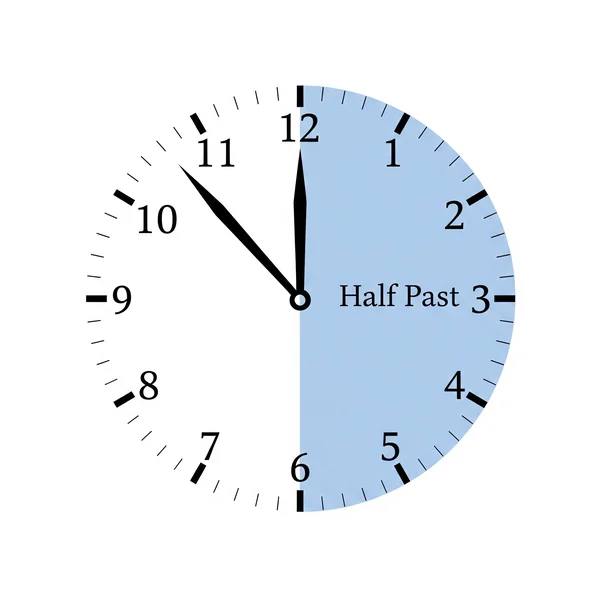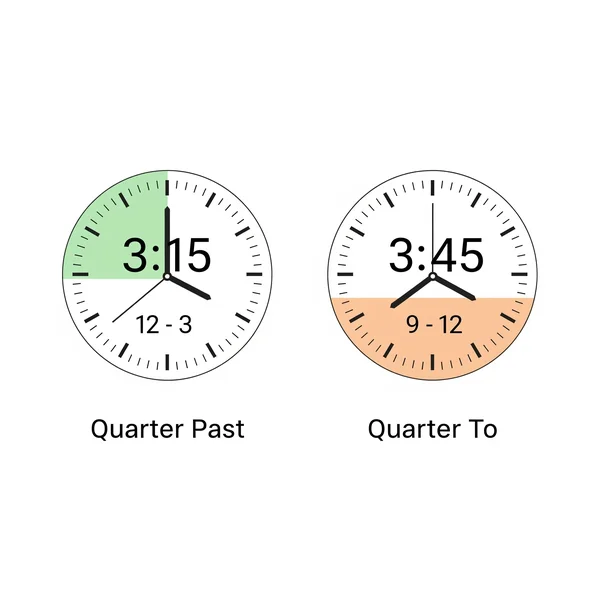Speaking Clock: Mastering 'Quarter Past' and 'Half Past'
You've learned to read the numbers on a clock—that's fantastic! You can see "3:15" and know exactly what it means. But have you ever heard someone say "a quarter past three" and wondered what they were talking about? If you're ready to take the next step and speak about time like a pro, you're in the right place. What's the difference between "a quarter past" and "a quarter after"? This guide will unlock these common phrases, making telling time even more of an adventure. Let's begin this journey and practice telling time with new confidence.

Why Learning 'Telling Time Vocabulary' is Your Next Step
Moving beyond just numbers is a key skill. Learning the special words for telling time, or the telling time vocabulary, helps you understand and talk about time in a more natural way, just like the characters in your favorite books and movies.
From "Three-Fifteen" to "A Quarter Past Three"
Saying "three-fifteen" is perfectly correct, but saying "a quarter past three" shows a deeper understanding of the clock face. It shows you see the clock not just as numbers, but as a circle divided into parts. This is a huge step in mastering the analog clock!
How Common Phrases Help in Daily Conversations
How often have you heard "Let's meet at half past seven" or "The show starts at a quarter to eight"? These phrases are used everywhere in daily conversations. Understanding them means you'll never be confused about what time it is, whether you're at school, home, or watching a film.
The Easy Start: Understanding 'Half Past' the Hour
Let's begin with the simplest and most common phrase: 'half past'. It's the perfect starting point for building your new time-telling skills.
What Exactly Does 'Half Past' Mean? (The 30-Minute Mark)
When the long minute hand points directly down to the 6, it has traveled halfway around the clock face. That's why we call it half past the hour. It simply means 30 minutes have passed since the hour began. So, 8:30 is "half past eight."

Visual Guide: Finding 'Half Past' on Any Analog Clock
Look for the big hand on the 6. That's your signal for "half past." It doesn't matter where the small hour hand is (though it will be halfway between two numbers); if the minute hand is on the 6, you're looking at "half past." You can see this in action on our interactive clock by dragging the minute hand.
Examples to Practice: 6:30, 9:30, and 2:30
Let's try a few:
- 6:30 is "half past six."
- 9:30 is "half past nine."
- 2:30 is "half past two." See? You've already got it!
The Tricky Two: Mastering 'Quarter Past' and 'Quarter To'
Now for the next level! Understanding 'quarter past' and 'quarter to' is what truly separates the beginners from the experts. These two can seem tricky, but they follow a simple logic.
Decoding 'Quarter Past': 15 Minutes After the Hour
Think of the clock as a pizza. If you cut it into four equal slices, each slice is a "quarter." When the minute hand points to the 3, it has traveled one-quarter of the way around the clock. This is 15 minutes. So, "a quarter past" an hour means it is 15 minutes after that hour. For example, 7:15 is "a quarter past seven."
Understanding 'Quarter To': 15 Minutes Before the Next Hour
This is the opposite. When the minute hand points to the 9, there is only one-quarter of an hour (15 minutes) left until the next hour begins. We say it is "a quarter to" the upcoming hour. So, 7:45 is not "a quarter past seven," but "a quarter to eight," because it's 15 minutes away from being 8 o'clock.
Side-by-Side Comparison: 'Quarter Past' vs. 'Quarter To'
Let's make it crystal clear:
- 3:15 is A quarter past three. (15 minutes after 3)
- 3:45 is A quarter to four. (15 minutes before 4)
Visualizing this is the best way to learn. Take a moment to master clock reading by setting these times yourself on our tool.

Practice Makes Perfect: Using Our Interactive Analog Clock
Reading about time is one thing, but practicing is how you'll truly remember these new phrases. Our free online tool is perfect for this.
Step-by-Step: How to Set 'A Quarter Past 4' on Our Tool
- Go to our online analog clock.
- Click and drag the long minute hand to the 3.
- Drag the short hour hand to be just a little bit past the 4.
- Look at the digital display. It will show 4:15! You've just set "a quarter past four."
Fun Challenge: Convert Digital Time to 'Spoken' Time
Here’s a fun game to play. Use the "Random" button on our clock. A new time will appear. Before you look at the digital time, try to say the time using "half past," "quarter past," or "quarter to." Then, check your answer. It's a great way to test your skills!
Start Speaking Time Like a Pro Today!
Congratulations! You now know the secret behind telling time like a native speaker. You've learned that half past means 30 minutes past the hour, quarter past means 15 minutes after the hour, and quarter to means 15 minutes before the next hour.
The next time someone asks you for the time, you can confidently answer with more than just numbers. What time-telling phrase are you most excited to use first? Let us know in the comments below!
Your Top 'Quarter Past' and 'Half Past' Questions Answered
What's the difference between "a quarter past" and "a quarter after"?
Great question! They mean the exact same thing. "A quarter past" is more commonly used in British English, while "a quarter after" is more common in American English. Both are correct!
How can I explain "quarter to" to a 6-year-old?
Use a fun analogy, like a race. Tell them the little hour hand is racing to the next number. When the big minute hand is on the 9, it means the hour hand has only a "quarter of the track" left to go before it reaches the finish line (the next hour)!
Is it wrong to just say the numbers like "seven forty-five"?
Not at all! It's perfectly correct and clear. However, learning to say "a quarter to eight" shows a different, and often very useful, way of understanding time—it tells you how close you are to the next hour. You can see both ways at the same time with our fantastic learning clock to understand the connection.